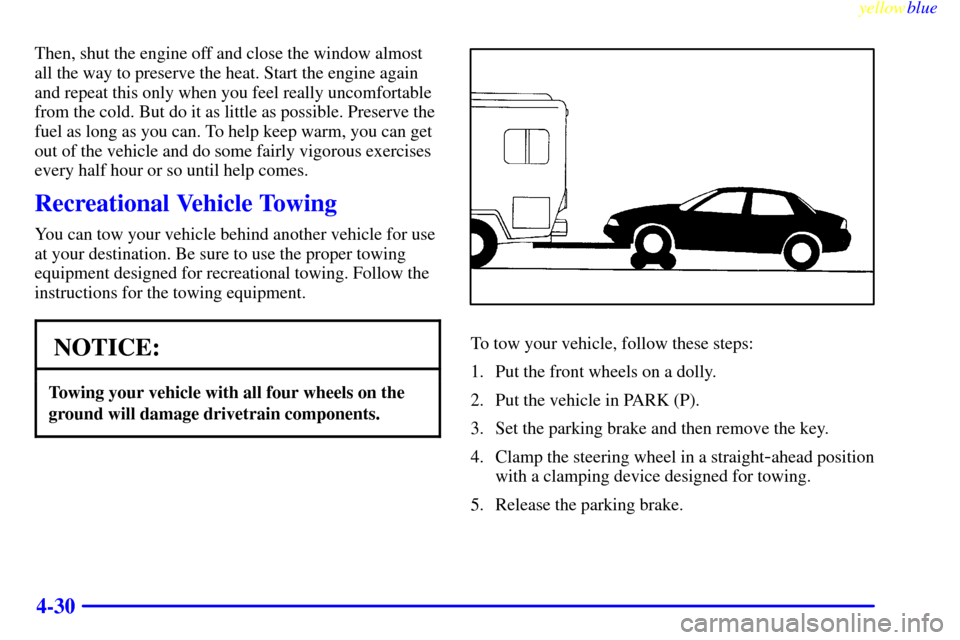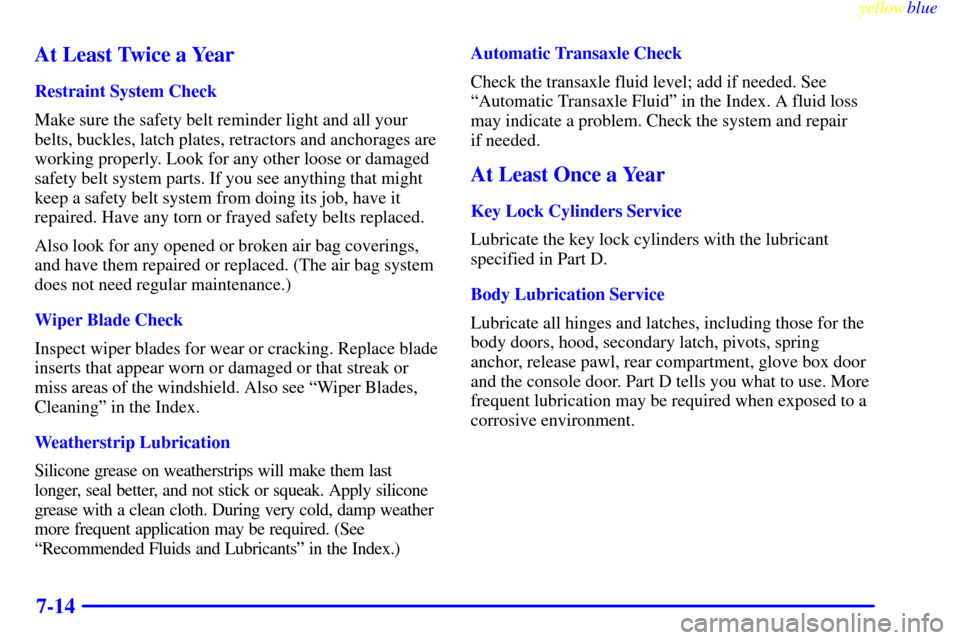Page 147 of 336

yellowblue
4-3
Drunken Driving
Death and injury associated with drinking and driving is
a national tragedy. It's the number one contributor to
the highway death toll, claiming thousands of victims
every year.
Alcohol affects four things that anyone needs to drive
a vehicle:
�Judgment
�Muscular Coordination
�Vision
�Attentiveness.
Police records show that almost half of all motor
vehicle
-related deaths involve alcohol. In most cases,
these deaths are the result of someone who was drinking
and driving. In recent years, over 17,000 annual motor
vehicle
-related deaths have been associated with the use
of alcohol, with more than 300,000 people injured.
Many adults
-- by some estimates, nearly half the adult
population
-- choose never to drink alcohol, so they
never drive after drinking. For persons under 21, it's
against the law in every U.S. state to drink alcohol.
There are good medical, psychological and
developmental reasons for these laws.The obvious way to solve the leading highway safety
problem is for people never to drink alcohol and then
drive. But what if people do? How much is ªtoo muchº
if the driver plans to drive? It's a lot less than many
might think. Although it depends on each person and
situation, here is some general information on
the problem.
The Blood Alcohol Concentration (BAC) of someone
who is drinking depends upon four things:
�The amount of alcohol consumed
�The drinker's body weight
�The amount of food that is consumed before and
during drinking
�The length of time it has taken the drinker to
consume the alcohol.
According to the American Medical Association, a
180
-lb. (82 kg) person who drinks three 12-ounce
(355 ml) bottles of beer in an hour will end up with a
BAC of about 0.06 percent. The person would reach the
same BAC by drinking three 4
-ounce (120 ml) glasses
of wine or three mixed drinks if each had 1
-1/2 ounces
(45 ml) of a liquor like whiskey, gin or vodka.
Page 174 of 336

yellowblue
4-30
Then, shut the engine off and close the window almost
all the way to preserve the heat. Start the engine again
and repeat this only when you feel really uncomfortable
from the cold. But do it as little as possible. Preserve the
fuel as long as you can. To help keep warm, you can get
out of the vehicle and do some fairly vigorous exercises
every half hour or so until help comes.
Recreational Vehicle Towing
You can tow your vehicle behind another vehicle for use
at your destination. Be sure to use the proper towing
equipment designed for recreational towing. Follow the
instructions for the towing equipment.
NOTICE:
Towing your vehicle with all four wheels on the
ground will damage drivetrain components.
To tow your vehicle, follow these steps:
1. Put the front wheels on a dolly.
2. Put the vehicle in PARK (P).
3. Set the parking brake and then remove the key.
4. Clamp the steering wheel in a straight
-ahead position
with a clamping device designed for towing.
5. Release the parking brake.
Page 186 of 336
yellowblue
5-2
Hazard Warning Flashers
Your hazard warning flashers let you warn others. They
also let police know you have a problem. Your front and
rear turn signal lamps will flash on and off.
Press the switch (located near the ignition switch) to
make your front and rear turn signal lamps flash on and
off. Your hazard warning flashers work no matter what
position your key is in, and even if the key isn't in.
To turn off the flashers, press the switch again. When
the hazard warning flashers are on, your turn signals
won't work.
Other Warning Devices
If you carry reflective triangles, you can set one up at
the side of the road about 300 feet (100 m) behind
your vehicle.
Page 237 of 336

yellowblue
6-17 Engine Oil Additives
Don't add anything to your oil. Your dealer is ready to
advise if you think something should be added.
When to Change Engine Oil
Your vehicle has a computer that lets you know when to
change your engine oil. This is not based on mileage,
but on engine revolutions and engine operating
temperature. When the computer has calculated that the
oil needs changing, the Oil Life Monitor will indicate
that a change is necessary. The mileage between oil
changes will vary depending on how you drive your
vehicle
-- usually between 3,000 miles (5 000 km) and
7,500 miles (12 500 km) since your last oil change.
Under severe conditions, the indicator may come on
before 3,000 miles (5 000 km). Never drive your vehicle
more than 7,500 miles (12 500 km) or 12 months
(whichever occurs first) without an oil change.
The system won't detect dust in the oil. So, if you drive
in a dusty area, be sure to change your oil every
3,000 miles (5 000 km) or sooner. Remember to reset
the CHG OIL SOON Light whenever the oil is changed.How to Reset the Oil Life Monitor
After changing the engine oil, the system must be reset.
With the ignition key in RUN but the engine off, fully
push and release the accelerator pedal slowly three times
within five seconds. If the CHG OIL SOON light
flashes, the system is resetting. Turn the key to OFF
then start the vehicle. If the CHG OIL SOON light
comes back on, the system has not reset. Repeat
the procedure.
What to Do with Used Oil
Did you know that used engine oil contains certain
elements that may be unhealthy for your skin and could
even cause cancer? Don't let used oil stay on your skin
for very long. Clean your skin and nails with soap and
water, or a good hand cleaner. Wash or properly throw
away clothing or rags containing used engine oil. (See
the manufacturer's warnings about the use and disposal
of oil products.)
Used oil can be a real threat to the environment. If you
change your own oil, be sure to drain all free
-flowing oil
from the filter before disposal. Don't ever dispose of oil
by putting it in the trash, pouring it on the ground, into
sewers, or into streams or bodies of water. Instead,
recycle it by taking it to a place that collects used oil. If
you have a problem properly disposing of your used oil,
ask your dealer, a service station or a local recycling
center for help.
Page 278 of 336

yellowblue
6-58
Fuse Description
12 Anti
-Theft/PCM -- Theft-Deterrent
Module, Powertrain Control Module,
(PCM) IGN System Relay
13 ABS
-- Electronic Brake Control
Module (EBCM), ABS Relay
14 HVAC Blower Motor
-- Blower
Motor Relay
15 L.H. Spot Lamp (S.E.O.)
16 Steering Wheel Control #1
-- Steering
Wheel Radio Control Lighting
17 Not Used
18 Not Used
19 Power Accessory #1
-- Door Lock
Switches, Trunk Courtesy Lamp, O/S
Mirror Switch, (S.E.O.) Emergency
Vehicle
-Rear Compartment Lid Lamp or
Window Panel Lamps
20 Steering Wheel Control #2
-- Steering
Wheel Radio ControlsFuse Description
21 Air Bag
-- Air Bag System
22 Cruise Control
--Cruise Control Cut-Out
Switch, Cruise Control Module, Turn
Signal Cruise Control Switches
23 Stoplamps
-- Stoplamp Switch (Brake)
24 Not Used
25 English/Metric (S.E.O.)
26 Not Used
27 Not Used
28 CTSY Lamps
-- Vanity Mirrors, I/P
Compartment Lamp, I/S Lighted
Rearview Mirror, Dome Lamp
29 Wiper
-- Wiper Switch
30 Turn Signal
-- Turn Signal Flasher
31 Not Used
32 Power Locks
-- Door Lock Relay,
Remote Keyless Entry Receiver
Page 279 of 336
yellowblue
6-59
Fuse Description
33 DRL MDL
-- Daytime Running Lamp
Module, (S.E.O.) Accessory Switch
34 Not Used
35 Not Used
36 Not Used
37 Rear Defog
-- Rear Window Defogger
Switch Relay
38 Radio
-- Radio, Power Drop
39 I/P Electronics Ignition Feed
--
Headlamp Switch, Instrument Cluster,
Chime Module, Keyless Entry Receiver,
Stoplamp switch (TCC and BTSI)
(S.E.O.) Accessory SwitchFuse Description
40 Not Used
41 Power Drop
42 Evap. Sol.
-- Evaporation Emissions
(EVAP) Canister Vent Solenoid Valve
43 Not Used
44 Not Used
45 Not Used
Page 300 of 336

yellowblue
7-14 At Least Twice a Year
Restraint System Check
Make sure the safety belt reminder light and all your
belts, buckles, latch plates, retractors and anchorages are
working properly. Look for any other loose or damaged
safety belt system parts. If you see anything that might
keep a safety belt system from doing its job, have it
repaired. Have any torn or frayed safety belts replaced.
Also look for any opened or broken air bag coverings,
and have them repaired or replaced. (The air bag system
does not need regular maintenance.)
Wiper Blade Check
Inspect wiper blades for wear or cracking. Replace blade
inserts that appear worn or damaged or that streak or
miss areas of the windshield. Also see ªWiper Blades,
Cleaningº in the Index.
Weatherstrip Lubrication
Silicone grease on weatherstrips will make them last
longer, seal better, and not stick or squeak. Apply silicone
grease with a clean cloth. During very cold, damp weather
more frequent application may be required. (See
ªRecommended Fluids and Lubricantsº in the Index.)Automatic Transaxle Check
Check the transaxle fluid level; add if needed. See
ªAutomatic Transaxle Fluidº in the Index. A fluid loss
may indicate a problem. Check the system and repair
if needed.
At Least Once a Year
Key Lock Cylinders Service
Lubricate the key lock cylinders with the lubricant
specified in Part D.
Body Lubrication Service
Lubricate all hinges and latches, including those for the
body doors, hood, secondary latch, pivots, spring
anchor, release pawl, rear compartment, glove box door
and the console door. Part D tells you what to use. More
frequent lubrication may be required when exposed to a
corrosive environment.
Page 301 of 336

yellowblue
7-15
Starter Switch Check
CAUTION:
When you are doing this check, the vehicle could
move suddenly. If it does, you or others could be
injured. Follow the steps below.
1. Before you start, be sure you have enough room
around the vehicle.
2. Firmly apply both the parking brake (see ªParking
Brakeº in the Index if necessary) and the
regular brake.
NOTE: Do not use the accelerator pedal, and be
ready to turn off the engine immediately if it starts.
3. Try to start the engine in each gear. The starter
should work only in PARK (P) or NEUTRAL (N). If
the starter works in any other position, your vehicle
needs service.Brake
-Transaxle Shift Interlock (BTSI) Check
CAUTION:
When you are doing this check, the vehicle could
move suddenly. If it does, you or others could be
injured. Follow the steps below.
1. Before you start, be sure you have enough
room around the vehicle. It should be parked on a
level surface.
2. Firmly apply the parking brake (see ªParking Brakeº
in the Index if necessary).
NOTE: Be ready to apply the regular brake
immediately if the vehicle begins to move.
3. With the engine off, turn the key to the RUN
position, but don't start the engine. Without applying
the regular brake, try to move the shift lever out of
PARK (P) with normal effort. If the shift lever
moves out of PARK (P), your vehicle's BTSI
needs service.